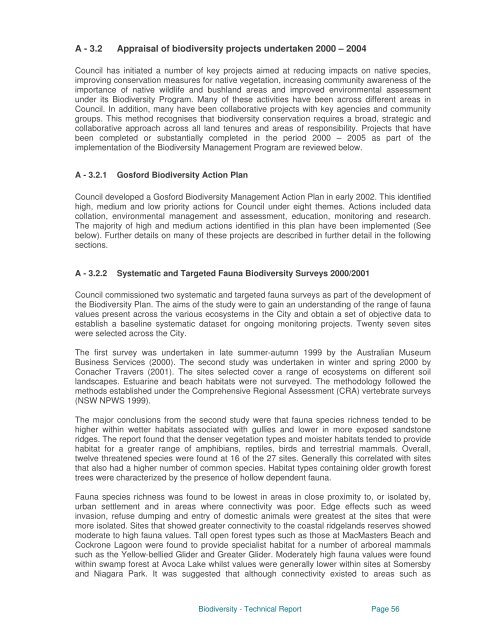Biodiversity Strategy - Gosford City Council - NSW Government
Biodiversity Strategy - Gosford City Council - NSW Government
Biodiversity Strategy - Gosford City Council - NSW Government
Create successful ePaper yourself
Turn your PDF publications into a flip-book with our unique Google optimized e-Paper software.
A - 3.2 Appraisal of biodiversity projects undertaken 2000 – 2004<br />
<strong>Council</strong> has initiated a number of key projects aimed at reducing impacts on native species,<br />
improving conservation measures for native vegetation, increasing community awareness of the<br />
importance of native wildlife and bushland areas and improved environmental assessment<br />
under its <strong>Biodiversity</strong> Program. Many of these activities have been across different areas in<br />
<strong>Council</strong>. In addition, many have been collaborative projects with key agencies and community<br />
groups. This method recognises that biodiversity conservation requires a broad, strategic and<br />
collaborative approach across all land tenures and areas of responsibility. Projects that have<br />
been completed or substantially completed in the period 2000 – 2005 as part of the<br />
implementation of the <strong>Biodiversity</strong> Management Program are reviewed below.<br />
A - 3.2.1<br />
<strong>Gosford</strong> <strong>Biodiversity</strong> Action Plan<br />
<strong>Council</strong> developed a <strong>Gosford</strong> <strong>Biodiversity</strong> Management Action Plan in early 2002. This identified<br />
high, medium and low priority actions for <strong>Council</strong> under eight themes. Actions included data<br />
collation, environmental management and assessment, education, monitoring and research.<br />
The majority of high and medium actions identified in this plan have been implemented (See<br />
below). Further details on many of these projects are described in further detail in the following<br />
sections.<br />
A - 3.2.2 Systematic and Targeted Fauna <strong>Biodiversity</strong> Surveys 2000/2001<br />
<strong>Council</strong> commissioned two systematic and targeted fauna surveys as part of the development of<br />
the <strong>Biodiversity</strong> Plan. The aims of the study were to gain an understanding of the range of fauna<br />
values present across the various ecosystems in the <strong>City</strong> and obtain a set of objective data to<br />
establish a baseline systematic dataset for ongoing monitoring projects. Twenty seven sites<br />
were selected across the <strong>City</strong>.<br />
The first survey was undertaken in late summer-autumn 1999 by the Australian Museum<br />
Business Services (2000). The second study was undertaken in winter and spring 2000 by<br />
Conacher Travers (2001). The sites selected cover a range of ecosystems on different soil<br />
landscapes. Estuarine and beach habitats were not surveyed. The methodology followed the<br />
methods established under the Comprehensive Regional Assessment (CRA) vertebrate surveys<br />
(<strong>NSW</strong> NPWS 1999).<br />
The major conclusions from the second study were that fauna species richness tended to be<br />
higher within wetter habitats associated with gullies and lower in more exposed sandstone<br />
ridges. The report found that the denser vegetation types and moister habitats tended to provide<br />
habitat for a greater range of amphibians, reptiles, birds and terrestrial mammals. Overall,<br />
twelve threatened species were found at 16 of the 27 sites. Generally this correlated with sites<br />
that also had a higher number of common species. Habitat types containing older growth forest<br />
trees were characterized by the presence of hollow dependent fauna.<br />
Fauna species richness was found to be lowest in areas in close proximity to, or isolated by,<br />
urban settlement and in areas where connectivity was poor. Edge effects such as weed<br />
invasion, refuse dumping and entry of domestic animals were greatest at the sites that were<br />
more isolated. Sites that showed greater connectivity to the coastal ridgelands reserves showed<br />
moderate to high fauna values. Tall open forest types such as those at MacMasters Beach and<br />
Cockrone Lagoon were found to provide specialist habitat for a number of arboreal mammals<br />
such as the Yellow-bellied Glider and Greater Glider. Moderately high fauna values were found<br />
within swamp forest at Avoca Lake whilst values were generally lower within sites at Somersby<br />
and Niagara Park. It was suggested that although connectivity existed to areas such as<br />
<strong>Biodiversity</strong> - Technical Report Page 56
















